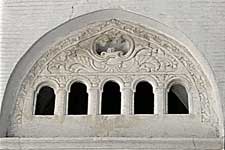Culture
 Popular art “flows” through the cells of the people of Tinos, who don't miss any opportunity to skilfully combine it with the Cycladic nature.
Popular art “flows” through the cells of the people of Tinos, who don't miss any opportunity to skilfully combine it with the Cycladic nature. This creates a unique style that you can only see in this island of the Cyclades.
Everyone who sought these beauties of Tinos called it “the island of artists”, while others called it a unique outdoor spectacle of popular art.
Dovecots are monuments of unique artwork, built mainly during the 18th and 19th century.
They are mainly stone buildings comprised by two floors. The lower floor is used as storage and the upper as dwelling of the doves.
They are mainly built on slopes at a particular angle towards the wind and the surrounding area, in order to facilitate the takeoffs and landings of the doves. The patterns on their outer side is believed to attract the doves.
They were created to raise them not only for their tasty meat, but also for the great manure created by their excrement.
Although they are found in most islands of the Cyclades, Tinos has the largest and most magnificent. Their number is not exactly known, however they certainly exceed 600.
Windmills are of course an integral part of the culture this island of the Cyclades.Tinos, as the island of winds, favours their operation. More than 80 operated, where, except for the local production, cereals from nearby islands were ground here too. Some are preserved until today, scattered in the nature of Tinos.
They played an important role during World War II, when they mainly ground barley for some bread during the terrible hunger on the island.
To understand how deep in time and the cells of people in Tinos Sculpture is, we should mention that the father of sculptor Feidias was from Tinos . More than 1000 marble craftsmen from Tinos, with their puncheon and marble from Tinos, made masterpieces of popular art. You can find numerous masterpieces throughout the island. Lintels decorated with ships, fishes, doves and trees, blazons on marble pediments over the doors, marble fountains, church temples and cenotaphs with representations and statues of exquisite art.
More than 1000 marble craftsmen from Tinos, with their puncheon and marble from Tinos, made masterpieces of popular art. You can find numerous masterpieces throughout the island. Lintels decorated with ships, fishes, doves and trees, blazons on marble pediments over the doors, marble fountains, church temples and cenotaphs with representations and statues of exquisite art.
This unparalleled style gives it a unique quality and value in comparison to the other islands of the Aegean.
The craftsmen of Tinos, except for marble, worked also with wood. Renowned wood-carvers, such as Chatzinikolos Printzis, Ioannis Kollaros and Ioannis Platis produced works such as the baldachin of Resurrection in Jerusale